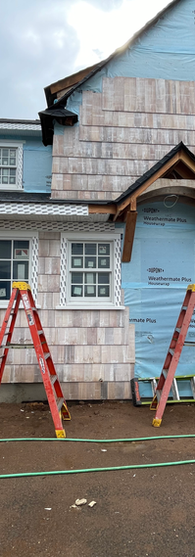V.H. CONSTRUCTION, INC.
NJ HIC 13VH02175600
201-389-6666
GENERAL CONTRACTING · FRAMING · SIDING · TRIM · FOUNDATION · MASONRY
Framing & Steel Installation
Framing work is a crucial phase in the construction process, forming the structural skeleton that supports the entire building. It involves the assembly of the framework, which includes walls, floors, and roofs, providing the shape and support for the entire structure. The framing stage is essential for ensuring the stability, durability, and overall integrity of the building.
Framing work requires a skilled and experienced team of carpenters. Their expertise is essential in overcoming challenges that may arise during the process, such as adjustments for uneven terrain, accommodating architectural features, or integrating necessary openings for doors and windows.
Framing work is the foundational stage of construction, laying the groundwork for the entire building. Precision, skill, and attention to detail are paramount during this phase, ensuring that the structure is not only stable and durable but also aligned with the architectural design and functional requirements of the building.
Foundation & Masonry
The foundation and masonry of a building form the bedrock of its structural integrity, providing the necessary support and stability for the entire structure. These two components work in tandem to create a solid base upon which the rest of the building is constructed.
The synergy between foundation and masonry is vital for the overall success of a construction project. A well-constructed foundation provides a stable platform for the masonry elements, while meticulous masonry work ensures the building's strength, durability, and visual appeal. The collaborative efforts of architects, engineers, and skilled craftsmen in designing and executing both foundation and masonry contribute to the longevity and resilience of the built environment.
Siding
Siding is an exterior cladding material applied to the walls of a building to protect it from the elements while enhancing its aesthetic appeal. This crucial component serves both functional and decorative purposes, contributing to the overall durability, insulation, and visual character of a structure. Siding options are diverse, ranging from traditional materials like wood to more modern alternatives such as vinyl, fiber cement, and metal.
Siding is a fundamental aspect of a building's exterior, offering both protective and decorative qualities. The wide array of available materials allows for versatility in design, catering to various architectural styles and homeowner preferences. Whether seeking a classic, rustic appearance or a sleek, contemporary finish, the choice of siding can profoundly influence a building's durability and visual identity.
Trim
Trim is the finishing touch that adds detail, character, and a sense of completeness to a building's exterior and interior. It serves both aesthetic and functional purposes, enhancing the architectural style, defining edges, and concealing joints and gaps. Available in various materials and styles, trim contributes to the overall design and visual appeal of a structure.
Trim is the meticulous finishing touch that transforms a structure from a mere assemblage of components into a visually cohesive and refined space. Whether used to create intricate detailing on a historic building or to achieve a clean, modern look in a contemporary home, trim plays a pivotal role in the overall aesthetics and functionality of both exterior and interior spaces.




















